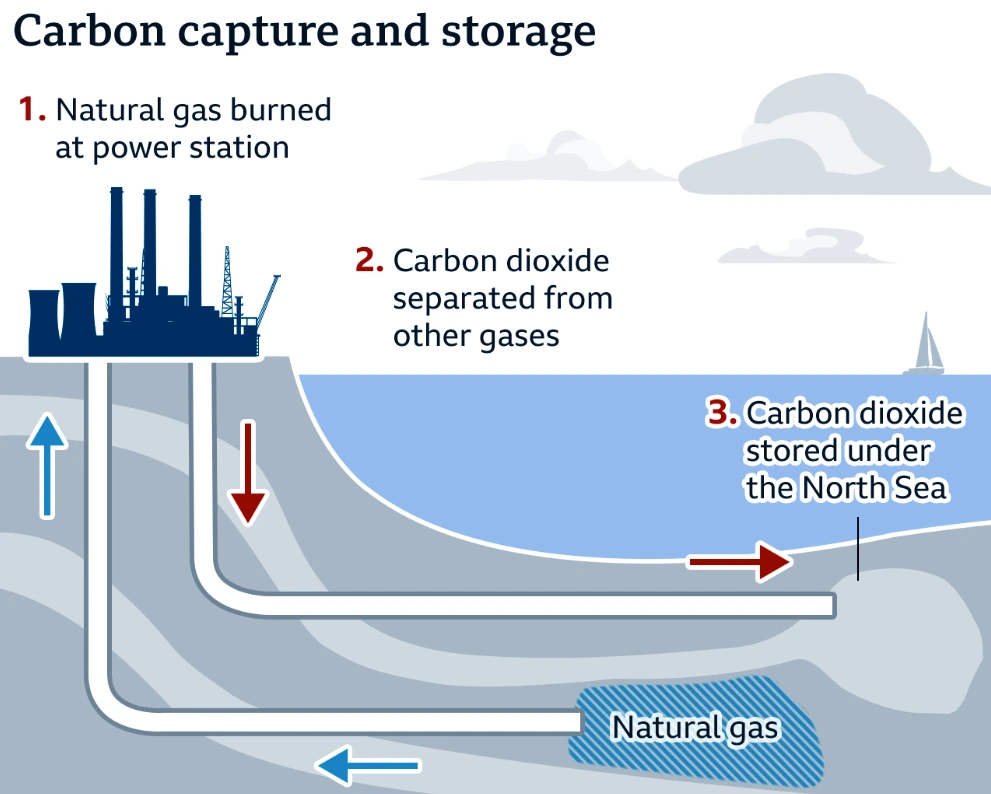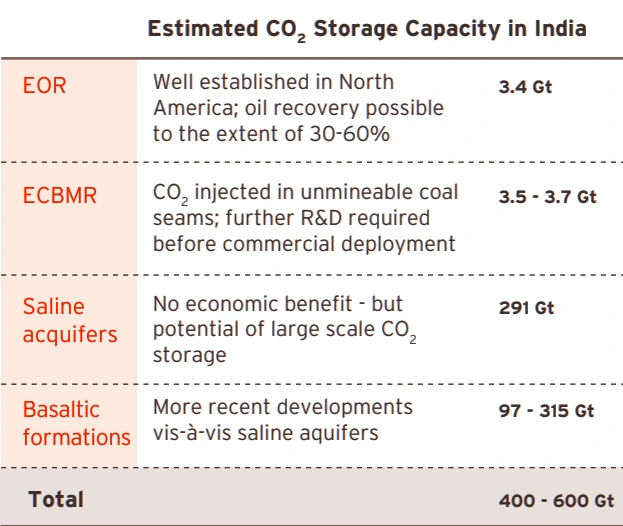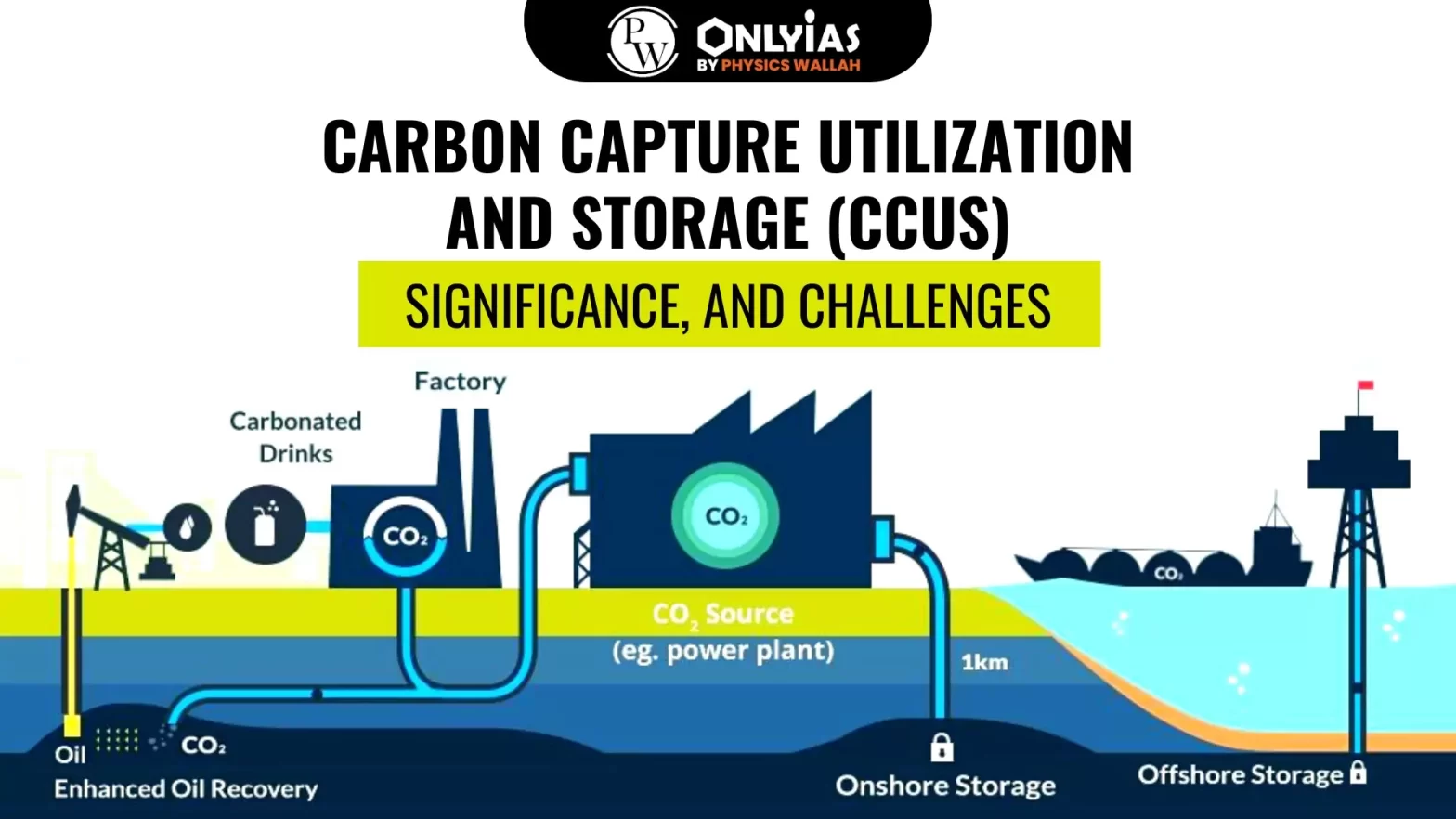Context: This article is based on the news “COP28: Relying on carbon capture and storage to reach Net Zero would be economically damaging, shows Oxford report” which was published in the DTE. According to a report by Oxford University, excessive dependence on Carbon Capture and Storage (CCS) to reach net zero goals would be economically damaging.
| Relevancy for Prelims: Carbon Capture Utilization and Storage (CCUS), Centre of Excellence in Carbon Capture and Utilization (NCoE-CCU), Mumbai, and the National Centre in Carbon Capture and Utilization (NCCCU).
Relevancy for Mains: Global and India’s status on Carbon Capture Utilization and Storage (CCUS), Its significance, and associated challenges with it. |
Global Status On CO2 Capture and Utilisation
- State of CO2 Capture: In 2022, the amount of CO2 being captured worldwide stood at just 49 MtCO2 per year.
- Pathways to CCS: According to the low-CCS pathway envisaged by the researchers, 4.4 gigatonnes of carbon dioxide (GtCO2) on average in 2050 would be mitigated compared to an average of 19.2 GtCO2 in the high-CCS pathway.
- From 2021 to 2050, taking a low-CCS pathway to Net Zero emissions will save approximately $1 trillion per year.
- A high-CCS pathway to decarbonisation to potentially mitigate half of today’s emissions in the oil and gas industry will cost an additional $30 trillion by 2050.
- CCS Projects: In 2023, 41 CCS projects are operational worldwide. Further, 351 CCS projects are in the pipeline.
- According to McKinsey analysis, Carbon Capture Utilization and Storage uptake needs to grow 120 times by 2050 for countries to achieve their net-zero commitments, reaching at least 4.2 gigatons per annum (GTPA) of CO₂ captured which could lead to Carbon Capture Utilization and Storage decarbonizing 45 percent of remaining emissions in the industry sector.
- Major Contributors of CO2: Industries that use fossil fuels such as power, iron and steel, cement, and transportation, are major contributors to carbon dioxide (CO2) emissions.
- Dependence on Thermal Power: Several large economies still depend on thermal power and this dependency is likely to continue until 2040. Additionally, CO2 is already in abundance in the atmosphere with a concentration level of about 415 parts per million (ppm) in 2020.
- In this context, Carbon Capture Utilization and Storage becomes unavoidable to reach the goal of limiting the global temperature rise to 1.5 °C.
Also Read: COP28 Climate Summit in Dubai

Carbon Capture Utilization and Storage in India:
- CO2 Emission: According to Niti Aayog’s Carbon Capture Utilization and Storage (CCUS) Report 2022, India is the 3rd largest emitter of CO2 in the world after China and the US, with estimated annual emissions of about 2.6 gigatonnes per annum (gtpa).
- Panchamrit Action Plan: It includes India’s commitment to reducing CO2 emissions by 50% by 2050 and reaching net zero by 2070.
- Carbon Capture Utilization and Storage: It is key to ensuring sustainable development and growth in India, particularly in the production of clean products and energy, leading to an Atmanirbhar Bharat.
- Carbon Capture Utilization and Storage Centres in India: The two Centres, namely the National Centre of Excellence in Carbon Capture and Utilization (NCoE-CCU), Mumbai, and the National Centre in Carbon Capture and Utilization (NCCCU), Bengaluru are being set up with support from the Department of Science & Technology.
|
What is Carbon Capture Utilization and Storage?
- Carbon Capture Utilization and Storage: It involves the capture of CO2, if not being used on-site, the captured CO2 is compressed and transported to be used in a range of applications, or injected into deep geological formations such as depleted oil and gas reservoirs or saline aquifers.
- Carbon Capture: CO2 is generally captured from large point sources like power generation or industrial facilities that use either fossil fuels or biomass as fuel.
- There are three main types of technological carbon capture which include:
- Industrial-Point-Source Capture: It is a technology that captures CO2 emissions from large emission sources, such as industrial facilities.
- Direct Air capture (DAC): It directly captures dilute CO2 (415 ppm) from the air and may also emerge as a form of carbon capture that has wide applicability as it is independent of the source and concentration of the emission stream. However, DAC is still in its early stages and the economics and scale of operations are yet to be established.
- Bioenergy with Carbon Capture and Storage (BECCS): It is a process that captures and stores carbon dioxide (CO2) from biomass.
- Carbon Utilization: These technologies can provide a wide variety of opportunities to convert the captured CO2 to value-added products with a ready market in India, thus contributing to the circular economy. The most promising utilization pathways are;
- Green urea: The total urea consumption in India is over 30 mtpa, and thus green urea provides a significant opportunity for CO2 utilization at scale.
- Food & Beverage Applications: CO2 is utilized in carbonated drinks, dry ice, modified atmosphere packing, etc.
- Building Materials: The large market for aggregates and concrete in India provides a pathway for utilizing CO2 for producing building materials.
- Chemicals: Conversion of CO2 to methanol and ethanol from CO2 is proven at a commercial scale which has important fuel substitution applications.
- Polymers (including bio-plastics): These polymers have multiple applications, such as laptop packaging, cell phone casings, furniture, etc.
- Carbon Storage: For effective Carbon Capture Utilization and Storage adoption at scale, apart from the conversion of CO2 to useful value-added products, there needs to be a clear strategy and pathway for the disposition of the captured CO2 through permanent geological storage.
- At present, the only commercial large-scale CO2 disposition option is geological sequestration. The options for the geological storage of CO2 include EOR (Enhanced Oil Recovery), ECBMR (Enhanced Coal Bed Methane Recovery), and permanent storage options like saline aquifers and basalt storage. Significance of Carbon Capture, Utilization and Storage.

What is the significance of Carbon Capture Utilization and Storage?
- Significant Role in Meeting Paris Agreement Target: Carbon Capture Utilization and Storage is vitally important for the world to have any chance of meeting the Paris Climate Accord objectives.
- For instance, almost all decarbonisation scenarios consistent with the 1.5°C target in the Paris Agreement contain some level of Carbon Capture Utilization and Storage.
- Decarbonising Critical Sectors: Carbon Capture Utilization and Storage offers the technology for decarbonizing the hard-to-electrify and CO2-intensive sectors such as steel, cement, oil & gas, petrochemicals & chemicals, and fertilizers.
Carbon Capture Technologies for Different Applications:
- Chemical Solvent-Based: Preferred when dealing with gas streams that are lean in CO2 and have relatively lower pressures, such as flue gas streams from power plants, BF gases in steel plants, gas streams in refineries or chemicals plants.
- Physical Solvent-Based: These work well on gas streams with relatively higher CO2 concentration and pressure, such as pre-combustion capture in the case of gasification projects.
- Adsorption-Based: Suitable for gas streams with moderate to high pressure and moderate CO2 concentration such as Steam Methane Reforming (SMR) flue gas or Blast Furnace (BF) gas.
- Cryogenic CO2 Capture: Preferred in cases where the cost of power is low. This technology provides a unique advantage of increasing the yield of hydrogen production from the same quantity of natural gas.
|
-
- These sectors are critical to the continued growth of the Indian economy and for ensuring energy, materials, and food security for the country.
- Nearly two-thirds of India’s crude steel capacity and 210 GW of coal-based power capacity have an age of less than 15 years which cannot be stranded and need to be made sustainable by retrofitting with CO2 capture and disposition infrastructure.
- Enabling the Sunrise Sectors: Carbon Capture Utilization and Storage is an enabler of least-cost low-carbon hydrogen production and is expected to play a major role in enabling the hydrogen economy in India, through the production of blue hydrogen (i.e. coal gasification-based hydrogen production coupled with Carbon Capture Utilization and Storage ) based on the utilization of India’s coal.
- Global Energy Mix: Oil, gas, and coal still made up around 81.5% of the global energy mix in 2022, down just 3% from 2015. Given the slow pace of the energy transition, Carbon Capture Utilization and Storage has the potential to become an important technology for achieving net zero.
- For instance, proper utilization of captured carbon can support the decarbonisation of other parts of the energy system, such as industry, trucks, and ships.
What are the challenges associated with Carbon Capture Utilization and Storage?
- Lack of Carbon Capture Utilization and Storage Scaling: Several challenges must be overcome before industrial point source Carbon Capture Utilization and Storage can reach scale, especially around policy and regulatory support, cost, and public acceptance. Based on the current Carbon Capture Utilization and Storage project pipeline, around 110 million tons per annum (MTPA) of CO₂ are expected to be captured annually by 2030.
- To achieve the net-zero commitments, approximately 715 MTPA are required by 2030 and 4,200 MTPA by 2050.
- Lack of Geological Data for Storage: The geological data on the pore space availability in India for the storage of CO2 is limited, especially for saline aquifers and basaltic storage.
- In the case of EOR and ECBMR, the data availability is better given the prior exploration activities for facilitating hydrocarbon extraction.
- Negative Externalities: Carbon Capture Utilization and Storage could also further pose risks to human rights, and put into jeopardy biodiversity and ecosystem services, deteriorating the resilience of our ecosystems and leading to problems of environmental injustice.
- Further, underground storage poses additional risks, such as potential leakage, contamination of drinking water, and stimulation of seismic activity.
- Lack of Technological Advances: Carbon Capture Utilization and Storage is recognized as a necessary and relatively low-risk approach to decarbonization, but the technology is not moving fast enough to achieve a 1.5° or even 2.0° pathway.
- For instance, over the last four decades, costs of solar, wind, and battery storage have fallen but the costs of fossil power with CCS have not declined, indicating a lack of technological advances.
- Further, CCS may be seen as offering oil and gas companies a free pass to keep extracting and burning fossil fuels.
- Economic Constraints. CCS technology is expensive to install and needs subsidies and financial incentives to encourage the industry to make the short-term capital investment needed.
Negative Externalities:
- They occur when a transaction has a cost that neither the buyer nor the seller is forced to pay.
- For example, a factory may release air pollution into the environment, incurring large social costs that neither the factory owners nor the consumers purchasing their product pay.
|
Way Forward:
- Prioritizing Important Sectors for Utilization: Carbon Capture Utilization and Storage technology is likely to be a scarce resource and governments should target Carbon Capture Utilization and Storage in sectors where it’s most likely to be needed.
- For instance, India may fund Carbon Capture Utilization and Storage demonstration projects in sectors such as coal-based power, steel, cement, refining & petrochemicals based on commercially proven technologies.
- Developing Alternatives: Governments should abandon claims that blanket CCS rollout is a sensible way to deliver net zero and the Paris Agreement goals.
- Reports from the Intergovernmental Panel on Climate Change (IPCC), do not show policymakers a single optimum or preferable pathway to 1.5°C, leaving room for alternative interpretations based on different priorities.
- For example, renewable energy, efficiency, and clean electrification are available alternatives with much greater feasibility, lower sustainability risks, and lower cost.
- Converting Captured CO2 to Value-Added Products: The opportunity to profitably decrease CO2 emissions using carbon utilization technologies can provide a wide variety of opportunities to convert the captured CO2 to value-added products with a ready market in India, thus contributing to the circular economy.
- For example, utilizing captured CO2 into green urea, carbonated drinks, building materials, chemicals like methanol and ethanol, etc.
- Technology Transfer: Technologies for carbon capture, CO2 sequestration, and EOR have been demonstrated at a commercial scale for almost 50 years in many parts of the world and particularly the US.
- While the development of indigenous technologies is certainly desirable, the immediate focus should be on the transfer, assimilation, and adoption of proven technologies in the Carbon Capture Utilization and Storage domain.
- Engagement with technology suppliers is also important to ensure the transfer and indigenization of technology and Intellectual Property (IP).
- Promoting Research & Development (R&D) in Novel CO2 Utilization Technologies: India should promote an ecosystem to foster R&D and innovation in CO2 utilization technologies and new products & applications based on CO2 utilization. CO2 utilization technologies are relatively less developed, compared to capture technologies.
- Technologies that have great potential for India, such as CO2 to methanol and CO2 to aggregates, are at different levels of development.
- Other technologies such as CO2 to synthetic fuels, polymers and novel materials like carbon nanotubes are even further behind on the development curve.
- Data Collection for Carbon Storage: To make the geological storage of CO2 a reality, further work is needed especially in the areas of source-sink mapping, pore space mapping, and geological characterization of the most promising CO2 storage regions & basins.
- Further developing the CO2 storage infrastructure through characterization, validation, and development of commercial-scale CO2 injection programmes in the selected sites.
- Private Sector Participation: It is essential to promote the transfer and commercialization of existing Carbon Capture Utilization and Storage technologies and also push for the development of new and emerging technologies.
- Public funding and favourable policies are required to incentivize & de-risk Carbon Capture Utilization and Storage projects, promote private sector participation and enable viable Carbon Capture Utilization and Storage business models and value chains to emerge.
Conclusion:
Carbon Capture Utilization and Storage (CCUS) holds significant promise in decarbonizing critical sectors and meeting global climate targets, the technology faces formidable challenges such as scaling issues, lack of geological data, and potential negative externalities.
To get PDF version, Please click on "Print PDF" button.



